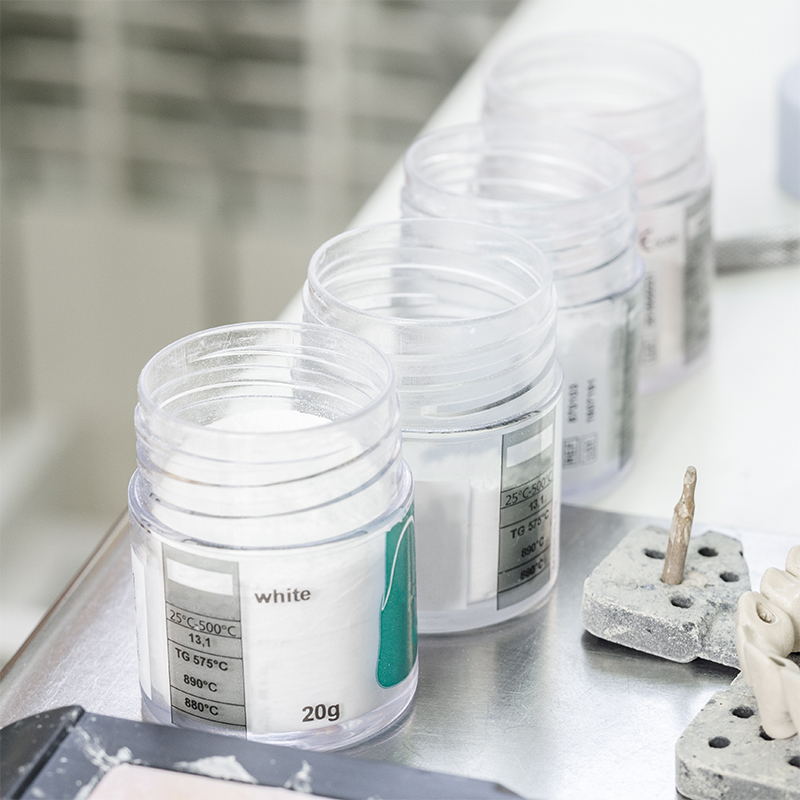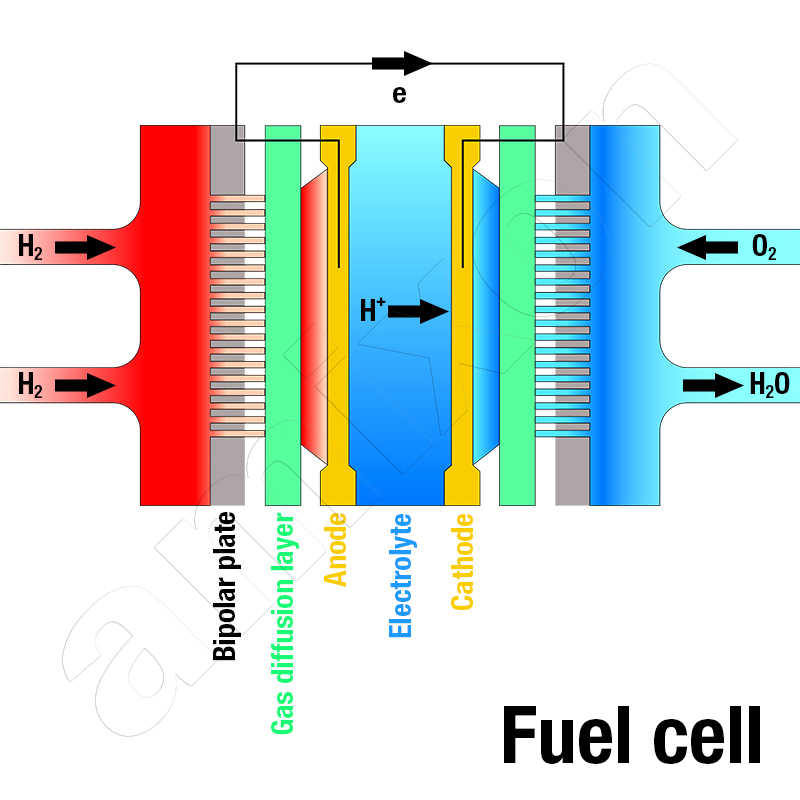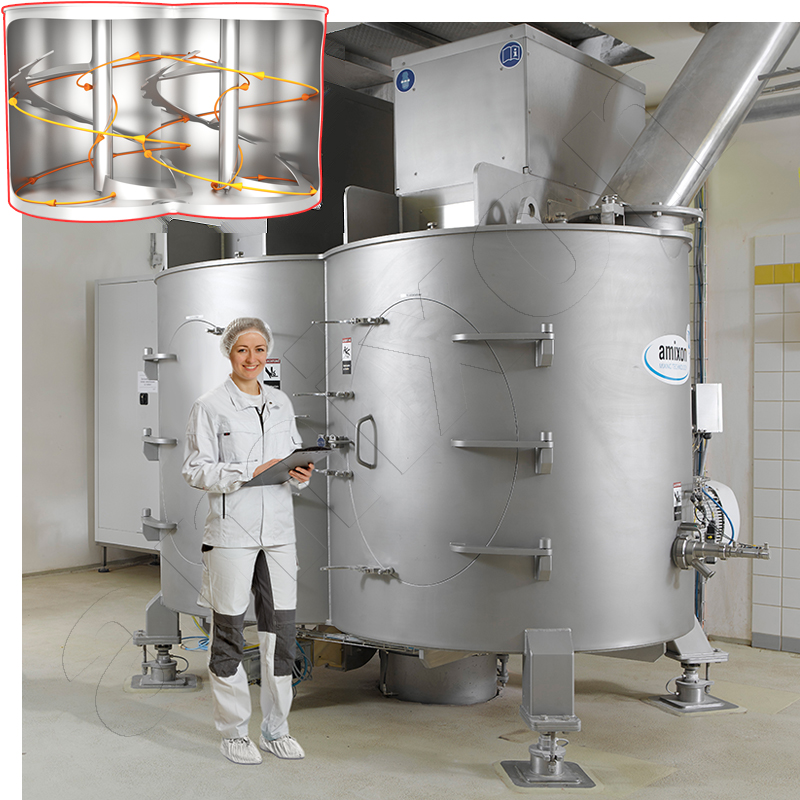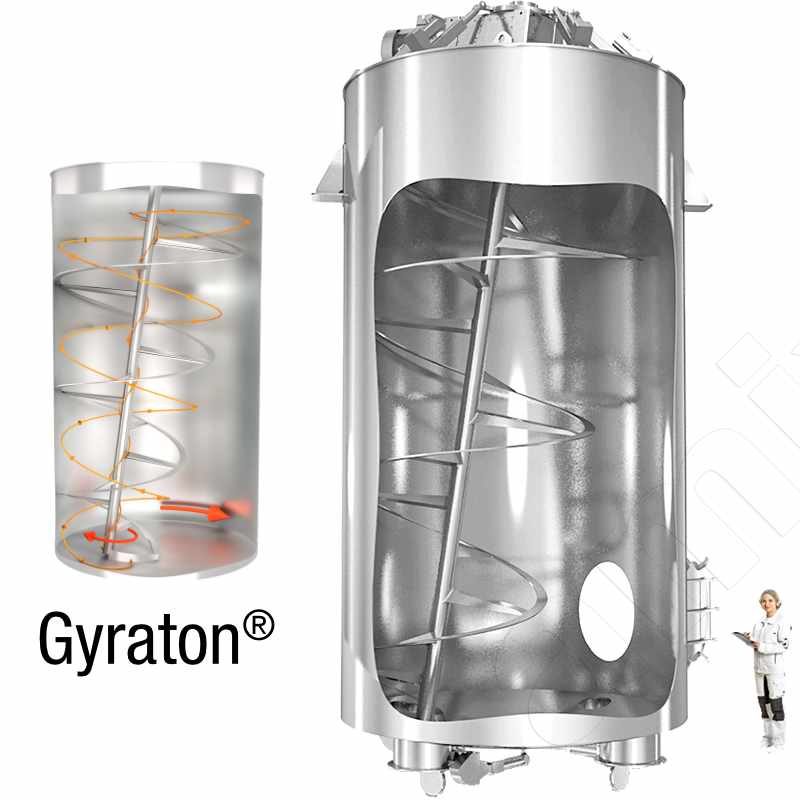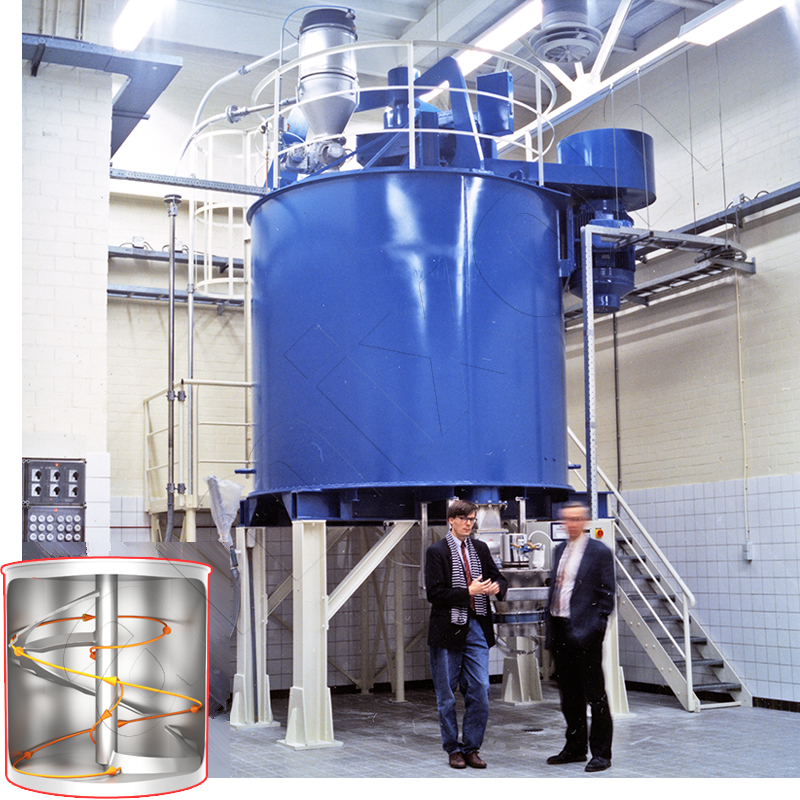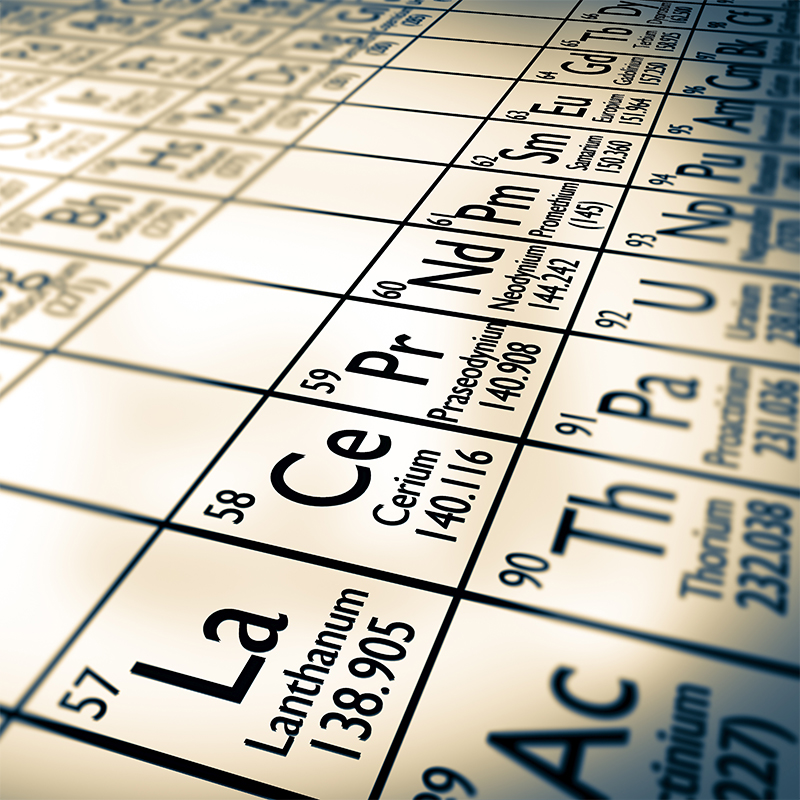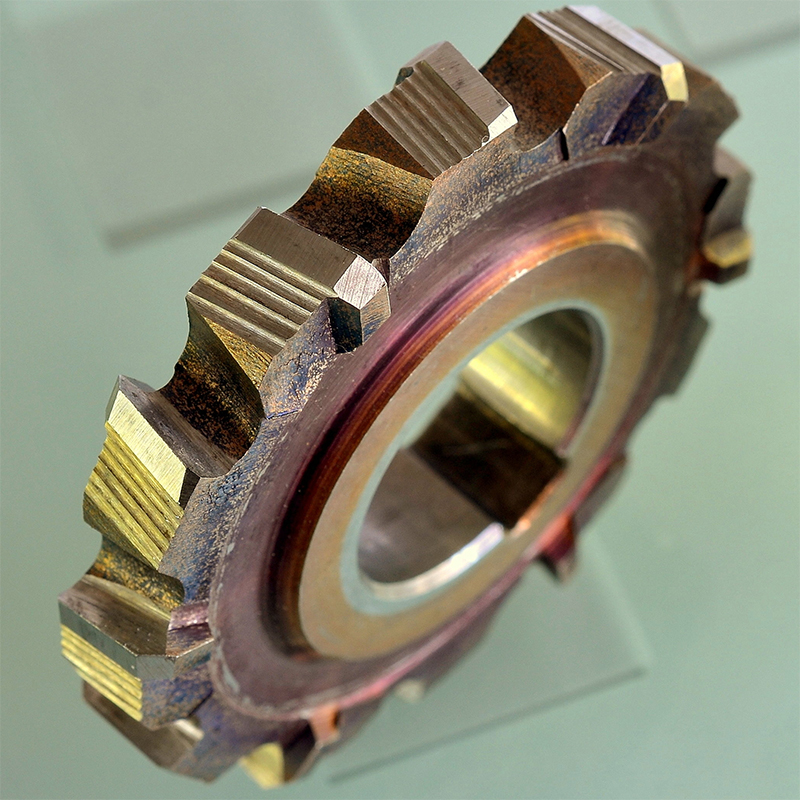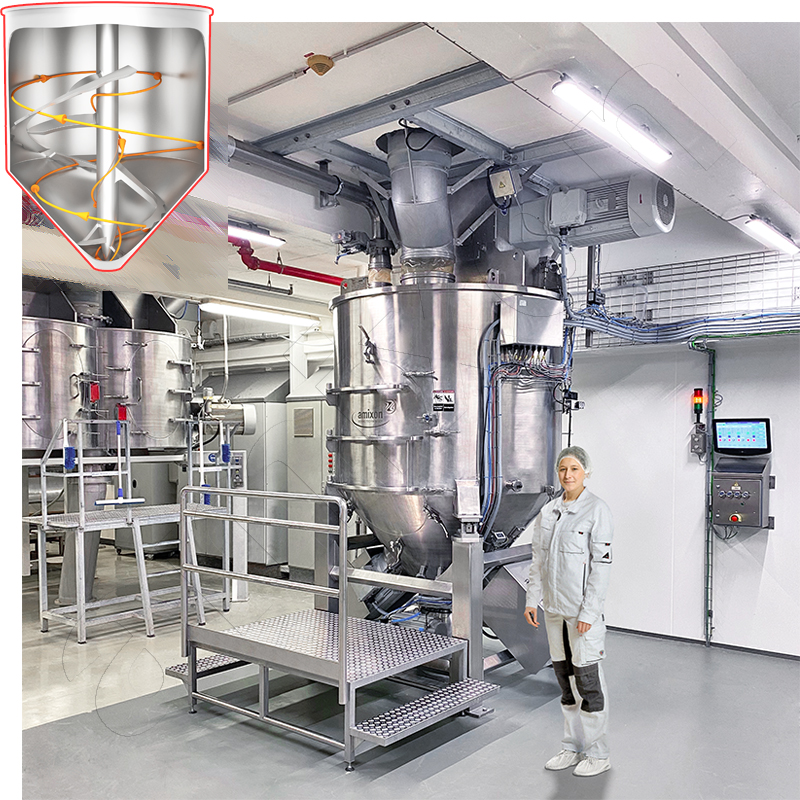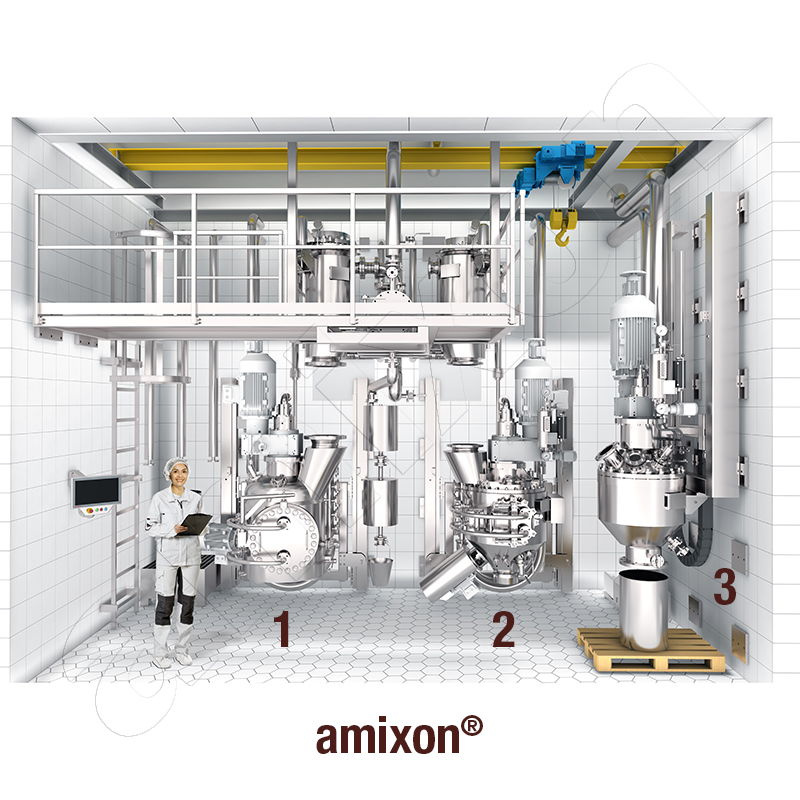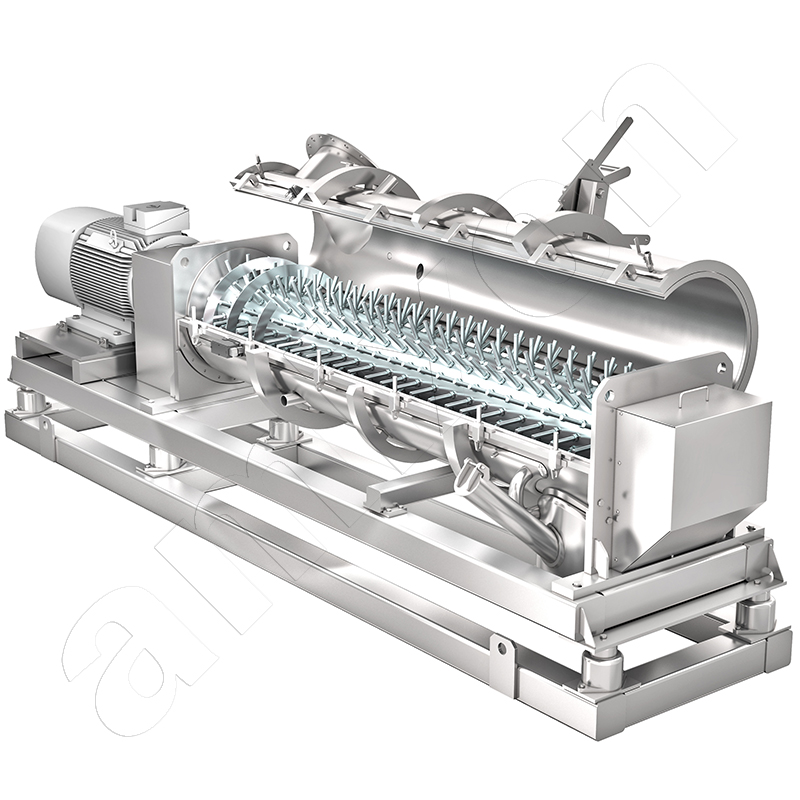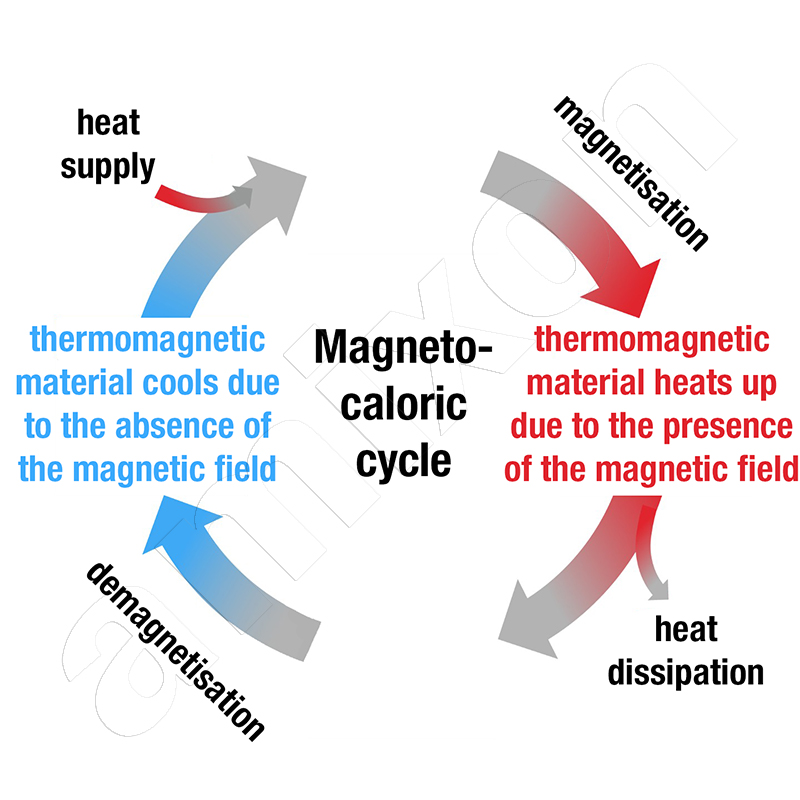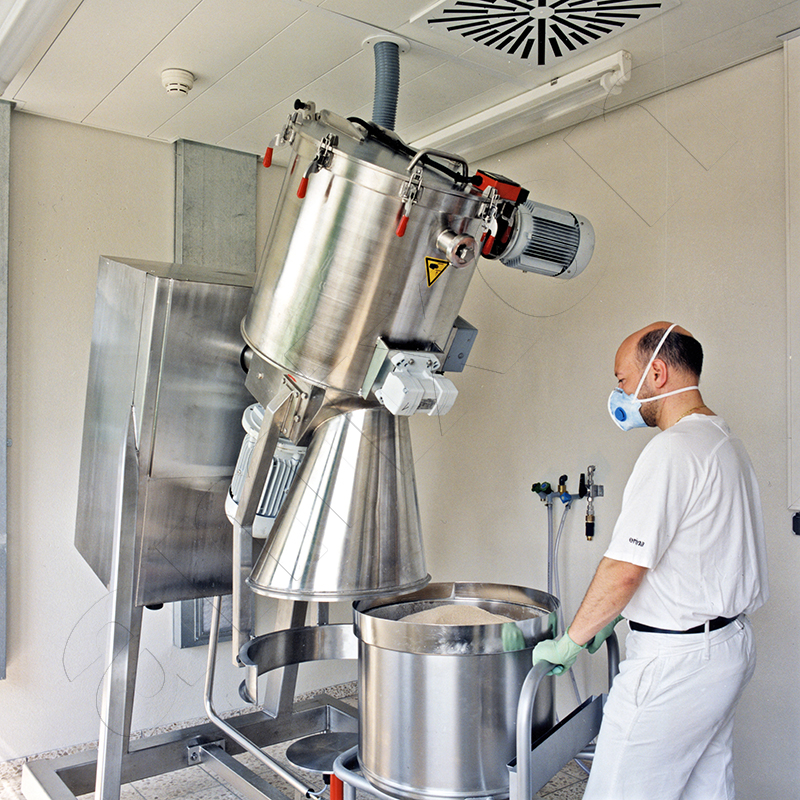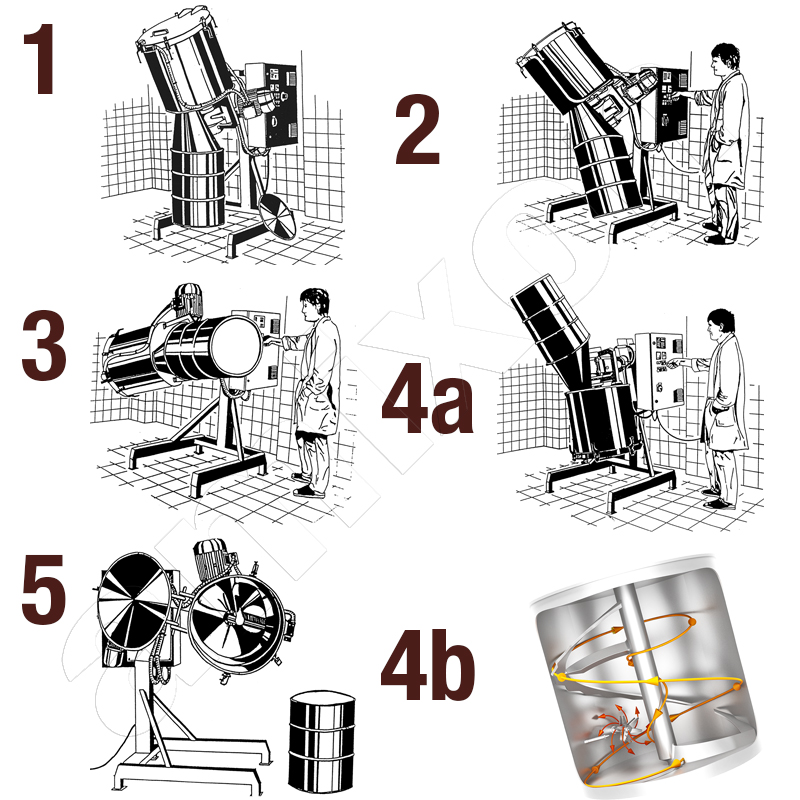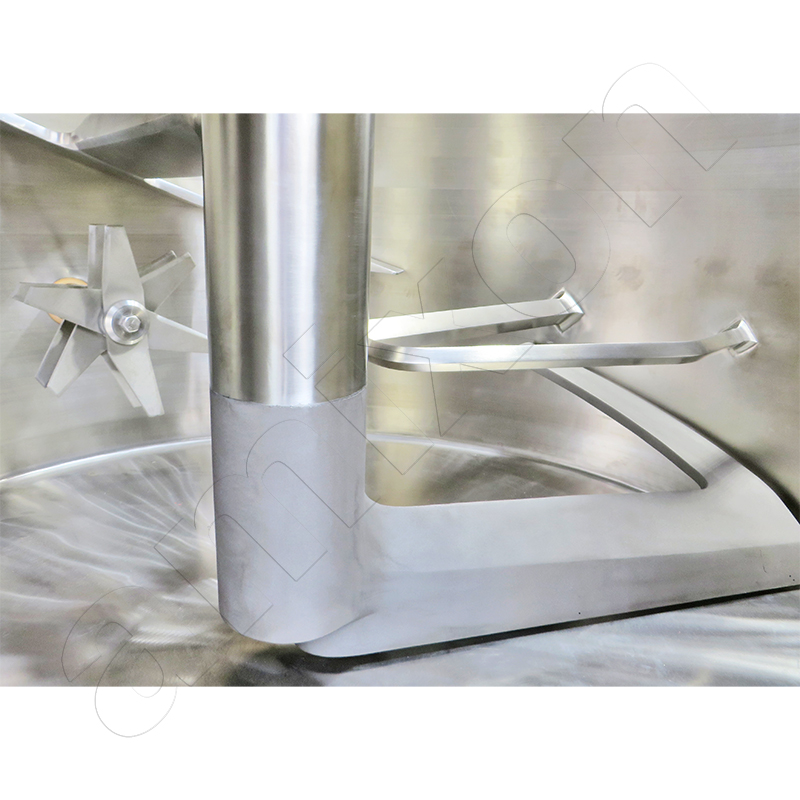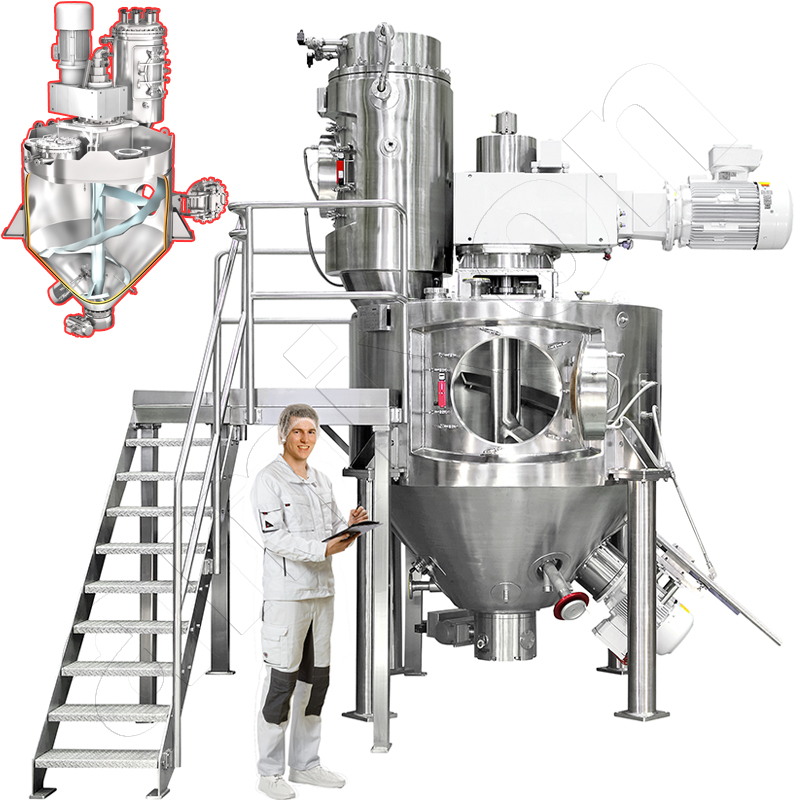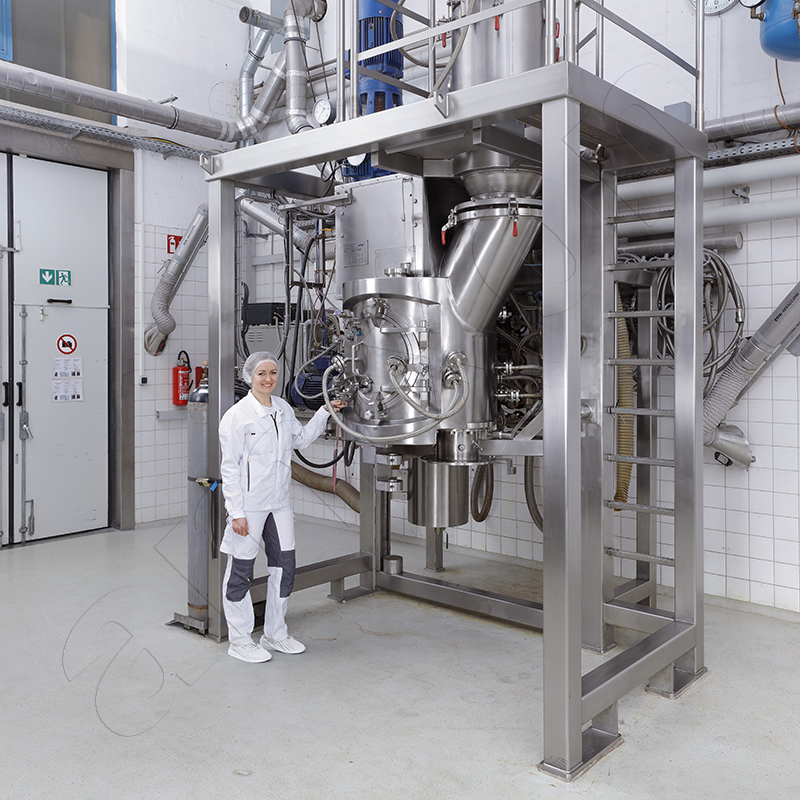Vertical mixers prepare high performance ceramics
Alongside plastics, ceramic materials are considered to have the greatest potential for development because of their unique stability, temperature resistance and durability. Engineering ceramics are used as a high-temperature-resistant material in power generation, as corrosion, acid and wear protection in apparatus engineering, and as high-frequency semiconductors in communications engineering.
In the production of technical ceramics, there are many parallels to the powder metallurgy. The raw materials used are expensive. These are oxides, nitrides, carbides or borides of high-purity metals. Examples are aluminum oxide, aluminum titanate, silicon carbide, silicon nitride and zirconium oxide. Due to their brittleness, ceramic components are prone to "critical failure". In the manufacture of advanced ceramics, therefore, the highest degree of purity must be ensured.
Short process times minimize abrasion
The mixing/ blending and deagglomeration of solids takes place as a quality-determining step in amixon® mixers. Three amixon® types have different application focuses. Since in some cases even clean room conditions have to be met, increasing importance is being attached to hygienic equipment designs.
The mixing elements of the amixon® mixers are designed as helically wound screw bands connected to the shaft via horizontally arranged arms. Due to the rotation of the spiral blade mixers, the dry, moist or suspended mixing goods are screwed upwards in the periphery and flow downwards along the shaft in the middle.
In the amixon® twin-shaft mixer/ blender, two helical ribbon mixing tools rotate synchronously
This allows component compositions of up to 1:1 000 000 to be homogeneously mixed in a very short time. The mixing quality corresponds to a technically ideal homogeneity. In practice, the mixing quality achieved cannot be improved any further.
A thrust reversal occurs inside the mixing chamber with each mixing tool revolution. This unique circumstance allows needle-shaped particles to align themselves completely independently of each other - at random. Needle-shaped particles would otherwise align themselves in the same direction and form so-called aggregates.
The ideal mixing quality is achieved regardless of the nature of the mixing goods (different properties such as particle size distribution, particle shape, moisture, adhesion and bulk density). The degree of filling can vary from thirty to one hundred percent of the useful capacity without affecting the achievable mixing quality. The use of twin-shaft mixers spans almost all demanding solid mixing tasks when the mixing time has to be short.
Silo blender: Many small batches are homogenized into one large batch
Most of the processes take place in continuously operating process equipment, the parameter settings of which have to be determined from upstream substance analyses. In this respect, the continuous individual steps must be carried out in sections and the intermediate products collected as batches in containers, silos, mixers or big bags. For representative analyses, a homogenous total mass must be assumed. The batch sizes to be homogenized in powder metallurgy vary between 5 l and 20 000 l. amixon® mixers are successfully used to achieve ideal mixing qualities. The three-dimensional circulation flow guarantees short mixing times.
amixon® single-shaft mixer/ blender
The VM type vertical single-shaft mixer, on the other hand, is mainly used where mixing time is of secondary importance. The best blending qualities are achieved in this machine as well. Due to the slow rotation speed, a very gentle mixing operation can be carried out in the same mixer.
For example, in the case of oxidation-sensitive products, the circumferential speed of the mixers can be set to less than 1 m/s. As a result, expensive inerting procedures can be avoided. Another advantage results from the smooth mode of operation. Hardly any vibrations occur. The mixed batches can be weighed very accurately.
Ceramics can be transparent like glass
Transparent ceramics can achieve bullet resistance equivalent to bulletproof glass, which is nine times heavier for the same suitability. The term functional ceramics also includes piezoelectric materials, semiconductors, microoptical, microelectromechanical sensor and electronic materials, and thermoelectric, ferroelectric, and magnetoelectric materials for high-frequency communications. Cooling processes are to become more economical and environmentally friendly by dispensing with fluorocarbons as an evaporating medium.
Ceramics have unique properties
Ceramics have unique specific properties unmatched by any other group of materials: extreme strength, high heat resistance, acid resistance, ductility, electrical and thermal conductivity, electrical insulation, optical refraction, transparency, color depth, etc.
Ceramic powders are prepared with the greatest care. In some cases, the starting components are converted to a state with an extremely high specific surface area. The particle sizes are smaller than 0.01 µm. This type of particle size reduction requires a high energy input.
Such small particles tend to agglomerate spontaneously. The agglomerates must be separated (deagglomerated) back into primary particles to ensure a uniform microstructure of the sintered material. The process chain is long: Raw material extraction from the chemical industry, defined surface enlargement, chemical breakdown, sieving, doping, homogenisation, dispersion in the wet phase, solid-liquid separation up to thermal drying, homogenisation/blending. The material diffusion takes place at high sintering temperatures in the calcining furnace. Cooling completes the first synthesis step. This is followed by similar or different preparation steps, which again start with grinding and mixing. If the composite contains plastic polymers, synthesis reactions can take place dry, wet and gaseous in the amixon® mixer.
Engineering ceramics
Traditionally, engineering ceramics plays an important role in the field of refractory and high temperature ceramics. Today, refractory materials are used at temperatures up to 1500°C. Examples include high-temperature combustion, steelmaking, glassmaking, and chemical processes that use hydrogen as a fuel.
Inorganic structural materials are created by biomaterialization
Engineering ceramics are the driving force behind efficiency improvements in many industries: For example, in healthcare, where ceramic materials are used for dental implants, bone substitutes, self-lubricating joints, prostheses, dentures and bioactive glasses with ever-improving compatibility and durability.
At the Institute of RWTH Aachen University, Professor Gonzales-Julian is working on a new and fascinating field of bioceramics: Living organisms produce inorganic materials through biomaterialization. In this way, biocompatible ceramics should one day be synthesized. A complementary field of research is ceramic composites for fiber composites, especially for highly stressed lightweight structures. Keywords here are bio-based or bio-inspired advanced ceramics.
The preparation of engineering ceramic masses involves numerous process steps.
The substances can be present in a wide variety of consistencies: As a liquid, as a structurally viscous or dilatant suspension, as a kneading compound or as a powdered bulk material. With the exception of kneading compounds, mixing preparation is usually carried out in batches. Depending on the task, amixon® can provide excellent solutions. Classic processes are mixing, agglomeration, synthesis reactions and vacuum mix drying. The process temperatures are up to 400°C. The system pressures in the reactor range from vacuum to 25 bar.
Ceramic components for environmental and process engineering
A wide variety of ceramics are used for refining and processing materials in process engineering for membranes, heat exchangers, catalysts, insulators and high-performance filters. Again, the combination of corrosion and temperature resistance makes oxide ceramics a universal material. Alumina ceramic coatings protect mixing tools from wear.
Ceramic sensors also function under harsh conditions. Ceramic circuits are printed on the running surfaces of ball bearings. They serve as pressure sensors and measure the load in fractions of a second.
Magnetocaloric effect
This is where a research-intensive subfield of advanced ceramics, magnetocalorics, comes into play. The aim is to replace expensive magnetocaloric metals such as gadolinium. This has been achieved in exemplary fashion with the powder-metallurgical composite material made of lanthanum, iron and silicon. Growing demand is expected for so-called soft magnetic composites (SMC). Iron powders are coated with an electrical insulator before pressing. This allows the magnetic flux to be guided three-dimensionally. Rare earths such as cerium (Ce), europium (Eu), cobalt (Co), lanthanum (La), lutetium (Lu), neodymium (Nd), praseodymium (Pr), samarium (Sm), terbium (Tb) and ytterbium (Yb) are used for particularly strong or heat-resistant magnets.
In the hydrogen, thermoelectric and fuel cell industries, ceramic composites are used in high-temperature electrolysis. The economic significance of the development field of ceramic solid electrolytes for batteries cannot be overestimated at present.
amixon® single-shaft mixer in compact format
Occasionally, the material manufacturer requires a precision mixer which, in addition to ideal mixing qualities, should also have the ability to discharge one hundred percent of the material residue. In this case, conical mixers can be used. Depending on the flowability of the powders, the residual discharge can be down to a few grams.
amixon® offers an ergonomic solution for piloting small volume processes. This mixer feeds and discharges itself. The entire process, i.e. feeding, mixing, filling as well as quality assurance, takes place in standard drums. This allows for pharmaceutically compliant cleanroom production.
It should be noted at this point that the results obtained in a small amixon® mixer are transferable to large amixon® mixers.
Inspection and cleaning can be carried out in an ergonomically exemplary manner. Operation is virtually emission-free.
Hygiene standards, which are common in the pharmaceutical and food industries, are also required for engineering ceramic products and in nanotechnology.
Wear-resistant ceramic materials
Another large sector covers wear-resistant ceramic materials for metal cutting. These are, for example, coatings applied to metallic bodies by plasma or flame spraying. These can be mixing tools or large-format mixing containers, but also high-precision machine elements such as shaft sleeves, valve seats or piston rings, which are subsequently ground to a micro-fine finish. Their surface then appears metallic bright. Ceramic coatings exhibit good tribological properties even at elevated temperatures. Ceramic coatings also have two particularly attractive properties. They can be exposed to high temperatures and are largely corrosion resistant. This makes them interesting for powder process technology, for turbo engines, for aircraft, and for gas and steam turbines.
Trials in the amixon® test center ensure a wide range of benefits for the user.
- Ideal mixing qualities even for the most difficult tasks => In this respect, a worthwhile investment with regard to future tasks.
- Discharge largely free of residues and segregation => Material feed as required; for fast discharge via large outlet; for slow-dosing discharge via small outlet.
- Bearing and drive of the agitators only above the mixing chamber => Almost maintenance-free shaft feed-through and sealing.
The amixon® team will be happy to demonstrate the application benefits described above through trials in our in-house technical center. Put us to the test with your original products - we guarantee you a high level of information gain in advance.
© Copyright by amixon GmbH

